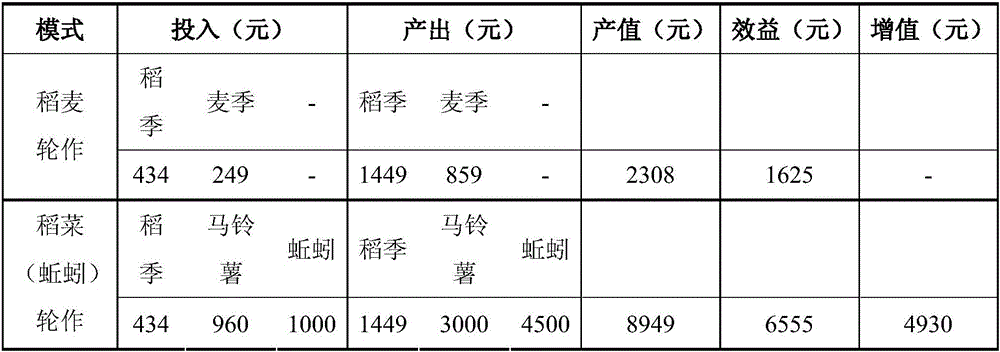Method for paddy-upland rotation rice and vegetable planting
A planting method and a technology of flood and drought rotation, applied in the agricultural field, can solve the problems affecting the acceptance and implementation enthusiasm of straw returning measures, the impact of wheat and rice planting and growth, the impact on yield and economic output, etc., so as to improve output efficiency, The effect of changing soil physical properties and accelerating treatment speed
- Summary
- Abstract
- Description
- Claims
- Application Information
AI Technical Summary
Problems solved by technology
Method used
Image
Examples
Embodiment 1
[0023] The rice-cauliflower (earthworm) model is implemented in Chongming Island. The average winter temperature of Chongming Island is 2.8°C, and the extreme minimum temperature on historical days is -10.5°C, which meets the conditions for open-air planting of cold-resistant vegetables. Specifically, start rice seedling cultivation in mid-to-late April, transplant rice seedlings by machine in mid-to-late October, and harvest rice when it is mature in mid-to-late October, and return the rice straw to the field in full by chopping (8-10cm) without straw transportation or burning. , and does not affect the planting and field management of the next crop of rice and vegetables; at the same time, cauliflower seedlings were raised in early October, and 800 kg of organic fertilizer was applied per mu of land in early November. Earthworm seedlings are 50 kg, and cauliflower is harvested from late April to early May of the following year, and earthworms are harvested in the field in ear...
Embodiment 2
[0027] The rice-potato (earthworm) model is implemented in Zhuanghang Town, Fengxian District. The average winter temperature in Fengxian District is 5.8°C, and the extreme minimum temperature is -7°C, which meets the conditions for outdoor planting of cold-resistant vegetables. Specifically, start rice seedling raising in late April, transplant rice seedlings by machine in late May, and harvest rice when it is mature in mid-to-late October, and return the rice straws to the field in full by chopping (8-10cm) without straw transportation or burning. And it will not affect the planting and field management of rice and vegetables for the next stubble; at the same time, put 50 kg of earthworm seedlings per mu of land, apply 800 kg of organic fertilizer per mu of land in late December, and start potato tuber seedlings in early January after plowing the whole border For planting, potatoes are harvested in early and mid-May of the following year, and earthworms are harvested in late ...
Embodiment 3
[0031] The rice-spinach (earthworm) model is implemented in Jiaxing, Zhejiang, where the average temperature in winter in Jiaxing is 5-12°C, which meets the conditions for open-air planting of cold-resistant vegetables. Specifically, start rice seedling cultivation in mid-to-late April, transplant rice seedlings by machine in mid-to-late October, and harvest rice when it is mature in mid-to-late October, and return the rice straw to the field in full by chopping (8-10cm) without straw transportation or burning. , and does not affect the planting and field management of the next crop of rice and vegetables; apply 1,000 kg of organic fertilizer per mu in late October, sow spinach in early November, and put 60 kg of earthworm seedlings in each mu of land, and harvest in late December spinach. Sow another batch of spinach in early March of the following year, harvest spinach in late April, and harvest earthworms in the field in early May.
[0032] Table 3: Comparison table of out...
PUM
 Login to View More
Login to View More Abstract
Description
Claims
Application Information
 Login to View More
Login to View More - R&D
- Intellectual Property
- Life Sciences
- Materials
- Tech Scout
- Unparalleled Data Quality
- Higher Quality Content
- 60% Fewer Hallucinations
Browse by: Latest US Patents, China's latest patents, Technical Efficacy Thesaurus, Application Domain, Technology Topic, Popular Technical Reports.
© 2025 PatSnap. All rights reserved.Legal|Privacy policy|Modern Slavery Act Transparency Statement|Sitemap|About US| Contact US: help@patsnap.com



